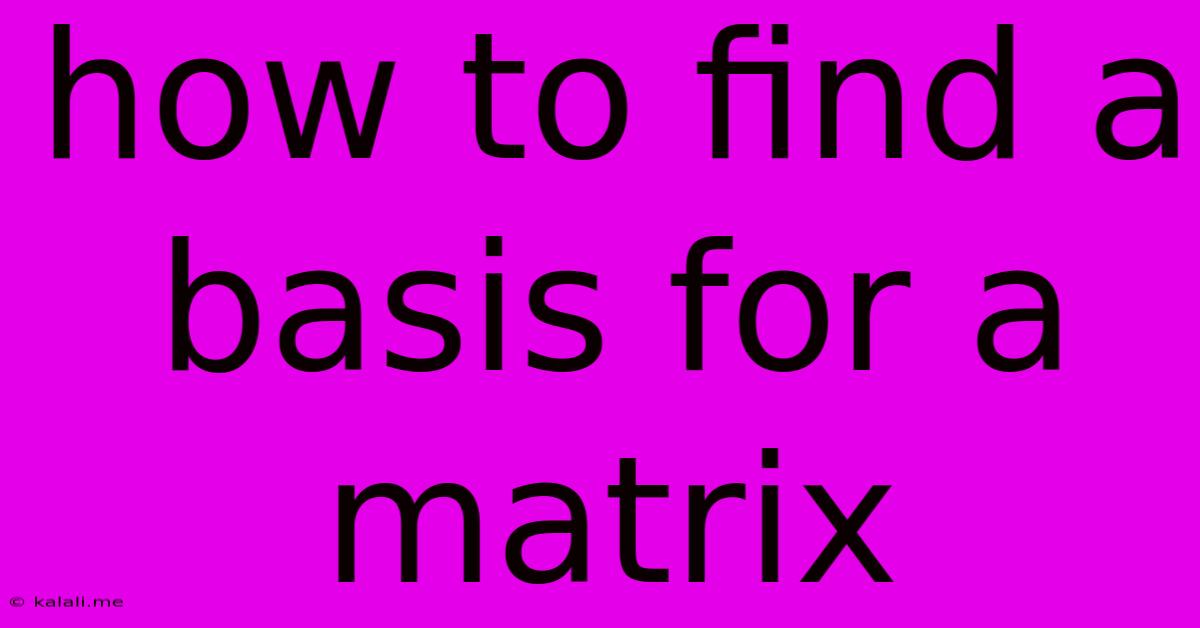How To Find A Basis For A Matrix
Kalali
May 31, 2025 · 3 min read

Table of Contents
How to Find a Basis for a Matrix: A Comprehensive Guide
Finding a basis for a matrix, specifically its column space or row space, is a fundamental concept in linear algebra. This guide will walk you through the process, explaining the underlying theory and providing practical examples. Understanding this allows you to determine the dimension of a vector space and gain crucial insights into the matrix's properties.
What is a Basis?
Before diving into the methods, let's clarify the definition. A basis for a vector space is a set of linearly independent vectors that span the entire space. This means any vector in the space can be expressed as a unique linear combination of the basis vectors. Finding a basis essentially boils down to identifying a minimal set of vectors that completely describe the space.
Finding a Basis for the Column Space (Column Space Basis)
The column space of a matrix is the span of its column vectors. To find a basis for the column space, we use the process of Gaussian elimination to identify the pivot columns.
Steps:
-
Form the matrix: Begin with the given matrix. Let's use the example matrix:
A = | 1 2 3 | | 4 5 6 | | 7 8 9 | -
Perform Gaussian elimination: Apply row operations (swapping rows, multiplying a row by a nonzero scalar, adding a multiple of one row to another) to transform the matrix into row echelon form or reduced row echelon form. The goal is to obtain a matrix where leading entries (pivots) are 1 and are the only nonzero entries in their respective columns.
-
Identify pivot columns: The columns in the original matrix that correspond to the columns containing leading 1s (pivots) in the row echelon form constitute the basis for the column space.
For our example, after Gaussian elimination, you might obtain a matrix like this (the exact form depends on the specific row operations):
R = | 1 0 -1 | | 0 1 2 | | 0 0 0 |The first two columns have leading 1s (pivots). Therefore, the first two columns of the original matrix A form a basis for the column space of A:
Basis = { |1| , |2| } { |4| |5| } { |7| |8| }
Finding a Basis for the Row Space (Row Space Basis)
The row space of a matrix is the span of its row vectors. We use a similar approach as for the column space, but we operate on the rows instead of columns.
Steps:
-
Transpose the matrix: First, transpose the matrix (swap rows and columns).
-
Perform Gaussian elimination: Apply row operations to the transposed matrix to achieve row echelon form or reduced row echelon form.
-
Identify nonzero rows: The nonzero rows in the resulting row echelon form (or reduced row echelon form) represent the basis for the row space of the original matrix. These are the linearly independent rows.
Understanding Rank and Nullity
The rank of a matrix is the dimension of its column space (or row space, since they have the same dimension). It represents the number of linearly independent columns (or rows). The nullity is the dimension of the null space (kernel) of the matrix, which is the set of all vectors that are mapped to the zero vector by the matrix transformation. The rank-nullity theorem states that rank(A) + nullity(A) = number of columns in A.
In Summary:
Finding a basis for a matrix involves Gaussian elimination to identify linearly independent vectors spanning the column space or row space. Understanding this process is crucial for comprehending the fundamental properties of matrices and their applications in various fields. Remember to always carefully perform row operations and correctly identify the pivot columns or nonzero rows to obtain an accurate basis.
Latest Posts
Latest Posts
-
2 3 Way Switches 2 Lights
Jun 01, 2025
-
Can You Frequent Trade On Cfd Account
Jun 01, 2025
-
How To Spell The Sound Of Crying
Jun 01, 2025
-
Water Leaking From Water Heater Drain Valve
Jun 01, 2025
-
How To Remove Dog Pee Scent
Jun 01, 2025
Related Post
Thank you for visiting our website which covers about How To Find A Basis For A Matrix . We hope the information provided has been useful to you. Feel free to contact us if you have any questions or need further assistance. See you next time and don't miss to bookmark.